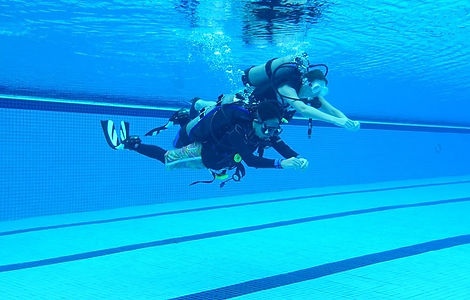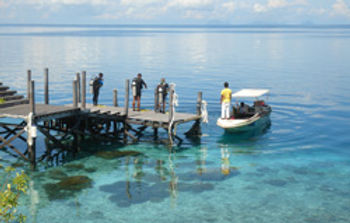CORE SCUBA COURSES
In the 'old days', learning to dive could take anywhere from 3 to 6 months of weekly lessons and pool sessions (depending on which country and club or agency you were training with). Learning to dive in France is still a multi-month programme. These days, in most places you can get your initial Open Water Diver certification in less than a week.
So what gives? How can diving have changed so much? Many will argue that it's the new equipment innovations that allow for shortened training time. But in reality, that's only half the story, at most. The truth is, that the original granddaddy scuba text, was and still is, the US Navy Dive Manual. But just imagine, the current version is 992 pages long. The 'old school' scuba training and certifications were based directly on this most valuable Navy tome. Hence, the long training timeframe, to get certified.
And today, what gives? How can we offer Open Water certifications in less than a week's time?
Well, the recreational scuba training agencies have essentially chopped up the 900+ pages of knowledge, (and all the water training that goes along), into 'bite-size' courses.
Thus, the truth is, when you finish your Open Water Diver certification, you've only started down the path to becoming a 'complete' diver. Knowing this, the next question you should be asking is: "What further knowledge and skills do I need to attain, to become that complete diver?"
Below is our answer (which means our opinion)... We've listed the courses which we consider fundamental for any diver around the world. Of course, in some areas, Ice Diving, Dry Suit Diving, or Altitude Diving must be added to this list.
But this list is appropriate for the waters of our Asian region.


OPEN WATER DIVER
-- The first diver certification for buddy diving
without professional supervision, max 18m --
Learn to Scuba Dive and Become a Certified Diver: This is where you start. The NASE Open Water Diver course is easy, fun and puts you on the road to a lifetime of learning and diving. The Open Water Diver course, however, is just the beginning. Once you have your c-card, you’ll be ready to start diving both close to home and at exciting vacation destinations. Equally important, you’ll be ready to take part in an assortment of fascinating continuing diver education courses to further polish your skills and expand your diving opportunities.

COMPUTER DIVER
Most new dive students today, are doing their Open Water certification dives, using a computer. This is great, but often the dive student leaves the Open Water Diver course without a complete and thorough understanding of how computers work, their functions, and how they may be used most effectively. This course provides the diver with the knowledge and training to make optimal use of dive computers. And often this course helps the diver to make an educated choice when it's time to buy their own computer.

BOAT DIVER
The ocean is filled with dive sites, but many of them cannot be reached from shore. This program gives you the skills and knowledge that will help you safely dive from a boat, allowing you to get the most from your underwater opportunities.

ADVANCED OPEN WATER DIVER
Be More, Do More: Imagine exploring a shipwreck nearly 30 m/100 ft below the surface or discovering how different the underwater world is at night. These are the kinds of things Advanced divers do.
Move beyond basic Open Water Diver certification. Start taking advanttage of the myriad opportunities available only to Advanced divers. The place to start is here.
The NASE Advanced Open Water Diver course lets you:
-
Gain additional knowledge and skills beyond those covered in entry-level scuba training.
-
Receive an introduction to several specialty diving activities.
-
Qualify to plan and conduct dives, with a similarly qualified buddy, to depths of 30 m/100 ft, in conditions similar to or better than those in which the divers were trained.
-
Gain additional dive experience under the guidance and supervision of an NASE Worldwide Instructor.


Stay Down Longer: Few things have revolutionized recreational diving in the past decade as much as the introduction of Enriched Air Nitrox (EANx).
Nitrox is nothing more than the air you are breathing right now with some additional oxygen added to reduce the concentration of nitrogen
While the additional oxygen offers no benefit in and of itself (and can, in fact, pose additional risk at depth), breathing less nitrogen provides divers with several benefits. Among them:
-
You enjoy longer no-decompression limits and shorter surface intervals — especially on repetitive dives.
-
You reduce the risk of decompression sickness compared to making the same series of dives using air.
-
Further benefits may include improved gas consumption, reduced fatigue and an overall feeling of well being.
-
If you own a modern dive computer, odds are it is capable of tracking your exposure to both air and Nitrox. Isn’t it time you started taking advantage of your computer’s capabilities?
Topics Covered: Among the many things you will learn as part of this program:
-
Enriched Air Nitrox: The advantages and drawbacks.
-
Equipment for diving EANx.
-
Using standard dive tables with Nitrox.
-
Managing oxygen exposure.
-
Analyzing EANx cylinders.
-
EANx and diving emergencies.
NITROX I & II
RESCUE DIVER
Be the Ultimate Dive Buddy: Beginning diver courses generally limit emergency skill training to self rescue and tired diver assists.
Why?
Beginning students lack sufficient knowledge, skill and experience to truly master complex rescue skills. There is simply not enough time in most beginning scuba courses to cover all the rescue and emergency management skills that every diver should have.
This is why the Rescue Diver course provides important follow-on training. It covers:
-
Self-rescue and diver stress.
-
Dive first aid.
-
Swimming and non-swimming rescue techniques.
-
Emergency management and equipment.
-
Panicked diver response.
-
Underwater problem solving.
-
Missing diver procedures.
-
Surfacing the unconscious diver.
-
In-water rescue breathing protocols.
-
Egress (exits).
-
First aid procedures for pressure related accidents.
-
Dive accident scenarios.
-
The Rescue Diver course also helps you meet important prerequisites for Master Diver, Divemaster and other leadership-level courses.


